Alfred Augustus Glendening Sr. stands as a significant figure in the rich tapestry of 19th-century British art. Active during the Victorian era, he dedicated his career to capturing the diverse and often idyllic beauty of the British landscape. Born in 1840 and passing away in 1921, Glendening Sr. witnessed immense social and industrial change, yet his work predominantly focused on the enduring tranquility and picturesque qualities of nature, particularly the waterways and rural scenes of England, Wales, and Scotland. His paintings, characterized by their sensitivity to light and atmosphere, found favour with the public and secured his place within the established art institutions of his time.
Though not born into artistic circles, Glendening Sr. navigated his way into the professional art world, leaving behind a legacy of works that continue to be appreciated for their technical skill and their evocative portrayal of a bygone era's relationship with the natural world. His journey from a railway clerk to a respected exhibitor at the Royal Academy exemplifies the possibilities for artistic dedication in Victorian Britain.
From Railway Clerk to Landscape Artist: An Unconventional Path
Alfred Augustus Glendening Sr.'s origins were relatively modest, offering little initial indication of his future artistic career. He was born in Greenwich, then a bustling area near London known for its maritime connections and burgeoning railway links, in 1840. His father worked variously as a docker and weigher, placing the family within the working fabric of the area. The family had previously resided in Hampton before moving to Greenwich.
In his early adulthood, Glendening Sr. pursued a conventional career path, securing employment as a clerk for a railway company. This role provided stability but seemingly did not fulfil his creative inclinations. During his twenties, while still employed full-time, he began to cultivate his passion for painting, dedicating his leisure hours to honing his skills. This period of self-directed study and practice laid the foundation for his eventual transition into a full-time artist.
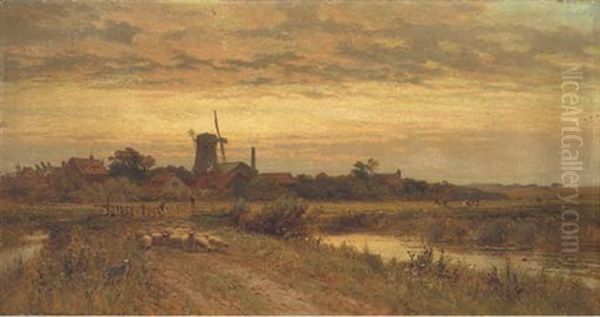
A significant personal milestone occurred in 1861 when, on March 3rd, he married Sophia Illman. While details of their life together are not extensively documented, this union likely provided a stable domestic background as he pursued his artistic ambitions. The decision to leave the security of his railway job and commit entirely to the uncertain life of an artist was a bold one, reflecting a deep-seated passion and growing confidence in his abilities.
Developing a Signature Style: Realism, Romance, and Light
Glendening Sr.'s artistic style evolved firmly within the traditions of British landscape painting, blending elements of detailed realism with a distinctly Victorian romantic sensibility. He was not an avant-garde innovator but rather a master craftsman working within established conventions, refining them to create his own recognizable aesthetic. His primary focus was the faithful yet often idealized representation of the natural world.
A key characteristic of his work is the meticulous attention to detail. Trees, foliage, water surfaces, and architectural elements are rendered with precision, demonstrating careful observation. However, this realism is tempered by a romantic feeling, often achieved through the manipulation of light and atmosphere. Glendening Sr. excelled at capturing the subtle nuances of natural light – the soft glow of morning, the warm hues of a summer evening, or the dappled sunlight filtering through leaves.
His handling of water was particularly adept. Rivers and lakes often feature prominently in his compositions, and he skilfully depicted reflections, the gentle movement of water, and the interplay of light on its surface. He often used a technique where light appears to enter the scene from outside the canvas, casting soft shadows and creating a sense of depth and tranquility. The inclusion of elements like swans gliding on a river or cattle grazing peacefully further enhances the idyllic and serene mood prevalent in much of his work.
Favourite Haunts: Charting the British Isles
Throughout his career, Alfred Augustus Glendening Sr. travelled extensively across the British Isles, seeking out picturesque locations that became the subjects of his paintings. His oeuvre provides a visual tour of some of the most scenic landscapes of Victorian Britain. The River Thames was a recurring and favourite subject, with locations like Hampton and Sunbury appearing in numerous works, often depicted with leisurely boating scenes that captured the recreational aspect of the river.
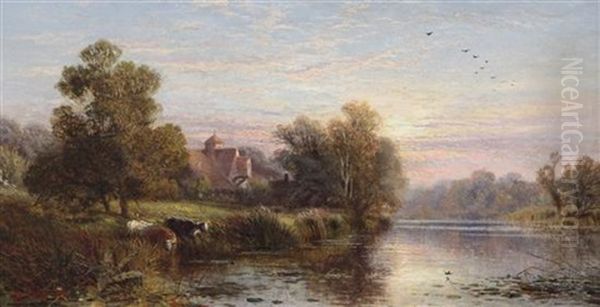
Beyond the Thames Valley, he was drawn to the diverse scenery of other regions. Wales provided inspiration with its rugged mountains and tranquil valleys. The dramatic landscapes of the Scottish Highlands, with their imposing peaks and lochs, offered a contrast to the gentler English scenes and allowed him to explore more sublime aspects of nature. The Lake District in England, renowned for its stunning combination of lakes and fells, also featured in his work.
He also painted coastal scenes, capturing the atmosphere of places like Southampton and the Isle of Wight. Rural life was another significant theme, with paintings often depicting agricultural activities such as harvesting or haymaking, presenting an idealized vision of pastoral harmony. Common motifs across these varied locations include meandering rivers, rustic cottages, ancient bridges, grazing livestock, and the ubiquitous presence of small boats, all rendered with his characteristic attention to atmospheric effect.
Exhibiting Success: Recognition in London and Beyond
Glendening Sr.'s transition to a professional artist was marked by his entry into the established exhibition system of Victorian London. His public debut appears to have been in 1864 at the Royal Society of British Artists (RSBA) on Suffolk Street, where he exhibited Morning on Grassmore Lake. This initial showing was quickly followed by acceptance at the most prestigious venue of all: the Royal Academy of Arts (RA).
In 1865, he exhibited A Cornfield - Kent at the Royal Academy, marking the beginning of a long and consistent relationship with the institution. He would continue to exhibit regularly at the RA summer exhibitions until 1903, submitting numerous landscapes that showcased his evolving skills and favourite subjects. Works shown at the RA during this period included titles like Summer Evening (1867), The Thames at Hampton (1873), Sunbury (1877), Belaugh on the Boreham, Norfolk (1879), and In the Meadows, Youngsberry (1900).
Beyond the RA and RSBA, Glendening Sr. also exhibited his work at other significant venues, including the British Institution. His paintings also reached audiences outside London, with works being shown in major regional galleries such as the Walker Art Gallery in Liverpool and the Manchester City Art Gallery. He also exhibited at the Dudley Gallery. This consistent presence in major exhibitions across the country cemented his reputation as a reliable and popular landscape painter throughout the latter half of the 19th century.
Masterpieces and Notable Works
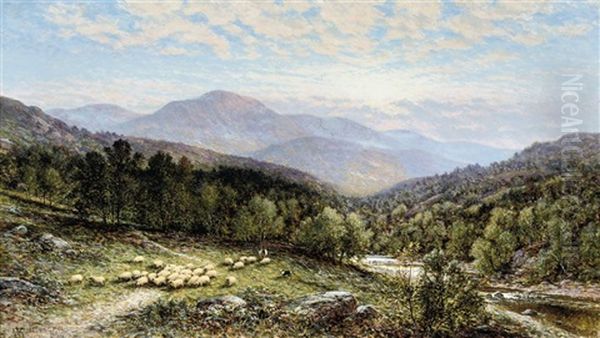
While Glendening Sr. produced a substantial body of work, several paintings stand out either as representative examples of his style or due to their subsequent history and recognition. His early exhibition pieces, such as Morning on Grassmore Lake (RSBA, 1864) and A Cornfield - Kent (RA, 1865), were crucial in establishing his career and demonstrating his early promise in capturing specific locations and atmospheric conditions.
The Thames at Hampton (RA, 1873) is a classic example of his popular river scenes, likely depicting the leisurely pace of life along the Thames, a subject favoured by Victorian audiences. Similarly, Along the Riverbank (1909), an oil painting measuring 24 x 42 inches, showcases his later style, continuing his focus on serene waterside views, rendered with delicate attention to light and reflection.
Haymaking, exhibited in 1898, represents his engagement with pastoral themes. This work gained significant recognition when it was acquired for the nation as part of the Chantry Bequest and entered the collection of the Tate Gallery (now Tate Britain), signifying a high level of official approbation. Other works depicting rural labour, like Harvest Time, further illustrate this aspect of his output, romanticizing agricultural life.
The enduring appeal and market value of his work are evidenced by auction results. Paintings like The Grand Finale and Off to the Hunt have achieved high prices in recent decades, demonstrating continued collector interest in his quintessential Victorian landscapes. These works, alongside many others depicting specific locales like Morning Light on the Grange Morecamme or Belaugh on the Boreham, Norfolk, contribute to a comprehensive picture of his artistic achievements.
Context and Contemporaries: The Victorian Art World
Alfred Augustus Glendening Sr. operated within a vibrant and complex Victorian art world. Landscape painting was immensely popular, catering to a growing middle-class market and reflecting a national pride in Britain's natural beauty, often seen as a counterpoint to rapid industrialization. Glendening Sr.'s idyllic and detailed style resonated with this taste. He exhibited alongside many of the era's most prominent artists at the Royal Academy and other institutions.
His direct contemporaries in landscape painting included figures like Benjamin Williams Leader (1831-1923), whose detailed and often panoramic views of the British countryside, particularly scenes in Worcestershire and Wales, shared some similarities in their accessible realism, though Leader often worked on a larger scale. George Vicat Cole (1833-1893) was another highly successful landscape painter focusing on Surrey and the Thames, known for his lush depictions of summer foliage.
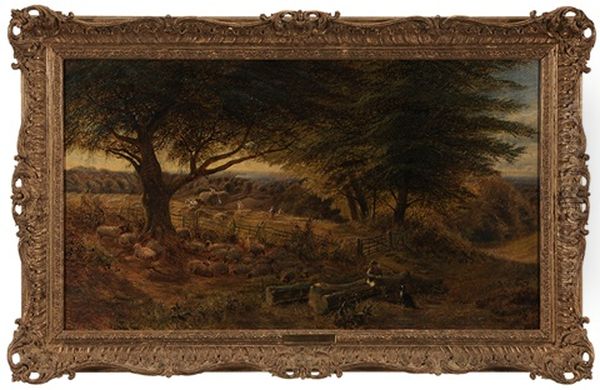
The atmospheric effects in Glendening's work, especially his handling of light, might invite comparison, though perhaps more by contrast, with the distinctive urban nocturnes and moonlit scenes of John Atkinson Grimshaw (1836-1893). While Glendening focused on the clarity of daylight or the soft glow of twilight in rural settings, Grimshaw explored the poetic melancholy of gaslight and moonlight on city docks and suburban streets.
The tradition Glendening worked within owed much to earlier masters like John Constable (1776-1837) and J.M.W. Turner (1775-1851), whose innovations had profoundly shaped British landscape art. While Glendening's style was less revolutionary, the legacy of Constable's naturalism and Turner's atmospheric brilliance informed the general approach to landscape in the Victorian era. The influence of watercolourists like David Cox (1783-1859), known for his fresh and direct studies of nature, particularly Welsh scenes, can also be seen as part of the broader context for landscape painters of Glendening's generation.
Within the Royal Academy itself, Glendening exhibited alongside artists working in diverse genres. Figures like William Powell Frith (1819-1909), famous for his detailed narrative scenes of modern life like Derby Day, represented a different facet of Victorian art. The Pre-Raphaelite Brotherhood, including John Everett Millais (1829-1896), initially challenged academic conventions but later became pillars of the establishment, with Millais eventually serving as RA President. The classical and often monumental works of Frederic Leighton (1830-1896), President of the RA for many years, represented the height of academic painting. Other popular artists included watercolourists specializing in charming rural scenes, such as Myles Birket Foster (1825-1899) and Helen Allingham (1848-1926), whose work shared a nostalgic appeal with Glendening's landscapes. The detailed coastal scenes of John Brett (1831-1902), associated with Pre-Raphaelite principles, also formed part of the rich artistic milieu.
Family Legacy and Recent Scholarship
Alfred Augustus Glendening Sr.'s artistic inclinations were passed down to his son, Alfred Augustus Glendening Jr. (c. 1861–1907). The younger Glendening also became a painter, working in a style that bore a strong resemblance to his father's, particularly in landscape subjects. This similarity has sometimes led to confusion in attributions, although Glendening Jr. also explored figurative subjects and interior scenes more frequently than his father, developing his own distinct reputation. He, too, exhibited widely and was popular in his time.
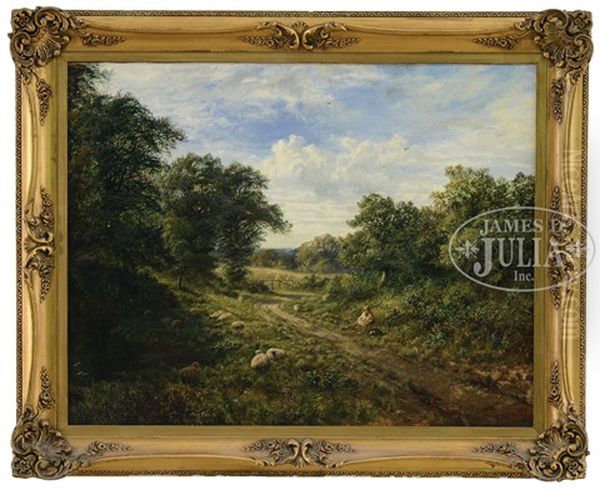
For many years, biographical details about Glendening Sr. were somewhat sparse or contained inaccuracies. However, recent scholarship has shed new light on his life and career. The publication of the book Capturing the British Landscape: Alfred Augustus Glendening (1840–1921) represents a significant contribution, correcting previous misconceptions about his dates, family background, and the trajectory of his career, particularly clarifying his early life and transition from railway work to professional painting.
This research underscores the narrative of an artist who, through dedication and talent, overcame a non-artistic background to achieve recognition within the competitive Victorian art market. His legacy is not only preserved in his numerous paintings but also enriched by a clearer understanding of the life behind the art.
Collections, Market Value, and Enduring Appeal
Today, works by Alfred Augustus Glendening Sr. are held in several public collections, ensuring their accessibility for study and appreciation. Notably, Tate Britain in London holds his painting Haymaking. His works are also found in collections outside the UK, including museums in Adelaide and Sydney, Australia, reflecting the reach of British art during the colonial era. Numerous other paintings reside in private collections worldwide.
The art market continues to show strong interest in Glendening Sr.'s work. His paintings appear regularly at auction houses, often commanding respectable prices. As mentioned, works like The Grand Finale and Off to the Hunt have achieved significant sums, indicating a sustained appreciation among collectors for his skillful execution and evocative subject matter. This market presence reflects his status as a solid representative of Victorian landscape painting.
His enduring appeal likely stems from several factors. His technical proficiency is evident in the detailed rendering and handling of light. Furthermore, his chosen subjects – the serene rivers, picturesque countryside, and dramatic coastlines of Britain – tap into a nostalgic appreciation for landscape beauty. His works offer an escape into idealized, tranquil visions of nature, a quality that perhaps resonates as much today as it did with Victorian audiences seeking respite from the complexities of modern life.
Conclusion: A Victorian Vision of Britain
Alfred Augustus Glendening Sr. carved a successful career as a landscape painter during a period of great artistic activity and public interest in the genre. Emerging from a non-artistic background, he dedicated himself to mastering the craft of oil painting, focusing his attention on the varied landscapes of the British Isles. From the gentle flow of the Thames to the rugged beauty of the Scottish Highlands, his works capture a sense of place imbued with tranquility and a subtle romanticism.
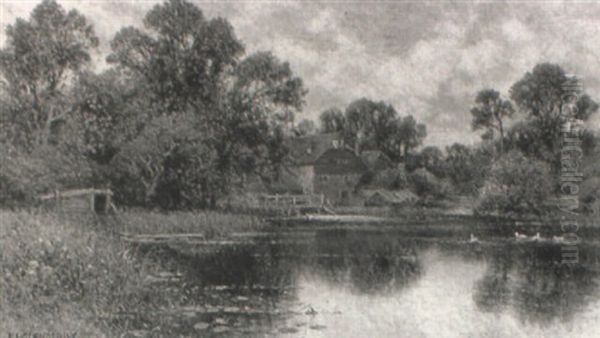
A consistent exhibitor at the Royal Academy and other major venues, he gained recognition and patronage, creating a substantial body of work characterized by careful observation, skilled rendering of light and water, and an overall peaceful atmosphere. While not a radical innovator, he excelled within the established traditions of British landscape painting, producing works that were, and remain, highly appealing. His paintings serve as beautiful documents of Victorian Britain's natural scenery and enduring testaments to the era's deep connection with its landscape.